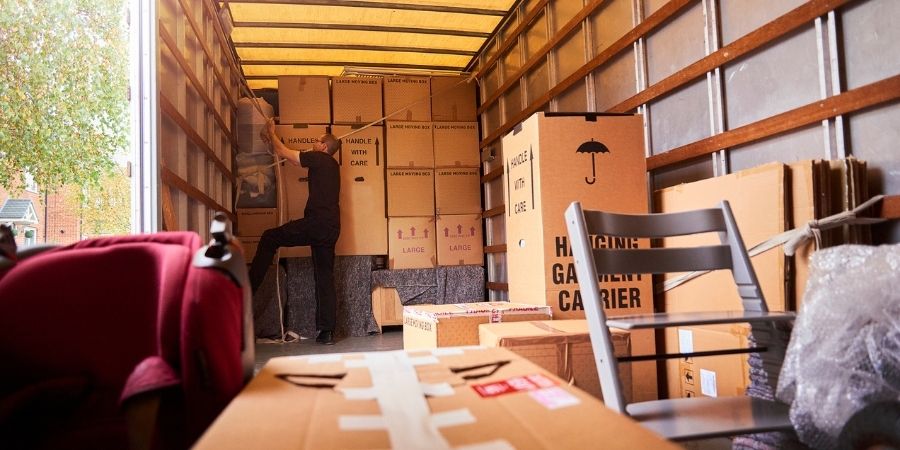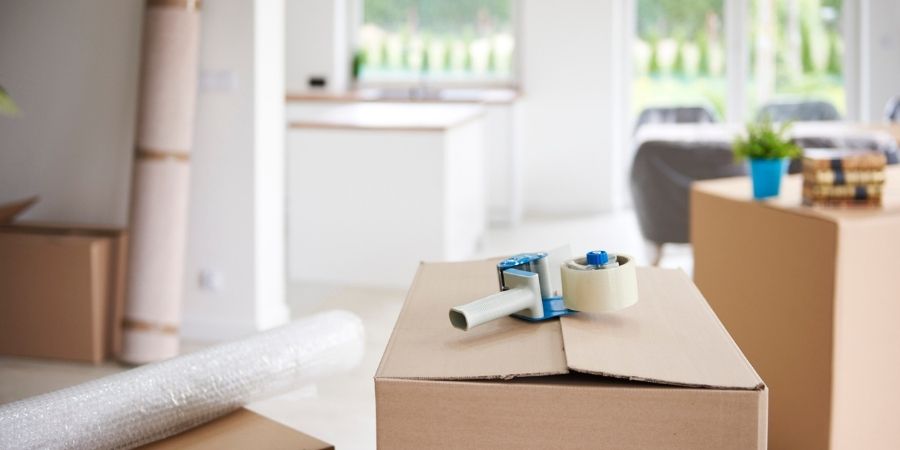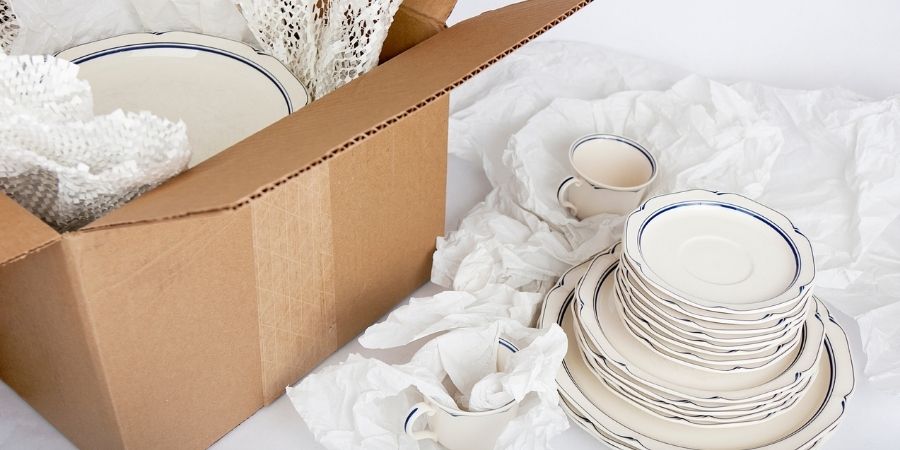Loading a moving truck takes precision and knowledge of how to appropriately stack and position items, so they don't fall over and crush other boxes. Hiring professional movers to do the heavy lifting for you can save you time and stress, but if you've decided to do it yourself, we've compiled some tips and tricks to help you out.
In this article, we’ll explain how to find a moving truck, how to find the right size truck and how to pack some of the more difficult items like furniture.
How to find the right moving truck for you?
There are many rental truck options these days, from small cargo vans to massive 26' trucks. Choosing the proper truck size is an important part of moving. If your truck is too small, you'll have to do multiple trips or get rid of items you may not want to part with. And if your truck is too big, you might increase the risk of items shifting or getting damaged.
If you've rented your truck a few months in advance, you stand a better chance of locking in a cheaper price. However, that means you have to guess how much stuff you'll end up taking with you, which can be difficult.


What kind of moving trucks can you rent?
There are several main companies that rent trucks. Four popular ones include U-Haul, Penske, Budget and Enterprise.
Each of these companies offers either cargo van or truck rentals of various sizes. Each company allows for both local and cross-country rentals, though the company may require you to pick up and drop off your vehicle in the same city.
| Types of Trucks by Moving Company | |
| Company | Truck Sizes Offered |
| U-Haul | 8’ Pickup Truck, 9’ Cargo Van, 10’ Truck, 15’ Truck, 17’ Truck, 20’ Truck, 26’ Truck |
| Penske | High Roof Cargo Van, 12’ Truck, 16’ Truck, 22’ Truck, 26’ Truck |
| Budget | Cargo Van, 12’ Truck, 16’ Truck, 26’ Truck |
| Enterprise | Several different options for Pickup Trucks, Cargo and Parcel Vans and;; 15’ 16’ Truck, 20’ Truck, 24’ Truck, 26’ Truck |


What truck size should you get?
When you’re going over your initial considerations to determine the perfect truck size, there are a few things to consider:
The more bedrooms and rooms you have, the larger your truck should be. (Especially if your beds are queen or king-sized.)
The approximate number of boxes you’ll need to move.
The kind of items you're moving. If you have large, antique pieces or a china cabinet that needs additional padding or protection.
Are you more comfortable driving a van or truck?
Are you moving locally or out of state?
We researched a few current offers from several moving companies to help you figure out which one might work best for you.
| Recommended Truck Size By Number of Boxes | ||
| Truck Size | Approx. Size |
Recommended For/Approx. # of Boxes* |
Pickup Truck - Recommended for small loads |
Dependent on bed size |
Home improvement items, lawn and garden equipment |
Cargo Van |
Up to 357 cu. ft. Small apartment or studio (1 room) |
Up to 92 medium boxes + one full mattress, one 3-seater sofa, one nightstand |
High-Roof Cargo Van |
Up to 404 cu. ft. Small apartment or studio (1 room) |
Up to 88 medium boxes + one queen mattress, one 3-seater sofa, one nightstand, one large chest of drawers |
10’ Truck |
Up to 402 cu. ft. Small apartment or 1 bedroom (1 to 2 rooms) |
Up to 89 medium boxes + one king mattress, one loveseat, two end tables, 4-piece dining set |
12’ Truck |
Up to 450 cu. ft. Small apartment or dorm room (1 to 2 rooms) |
Up to 105 medium boxes; one king mattress, one loveseat, two end tables, 4-piece dining set |
15’ Truck |
Up to 764 cu. ft. 1-2 bedrooms (2 to 3 rooms) |
Up to 165 medium boxes; one king mattress, washer and dryer, fridge, large dresser, one 3-seater sofa, two end tables, 4-piece dining set |
16’ Truck |
Up to 658 cu. ft Studio to 1-bedroom apartment (2 to 3 rooms) |
Up to 250 medium boxes, 1 to 10 pieces of medium-sized furniture |
17’ Truck |
Up to 865 cu. ft. 1 to 2 bedrooms (3 to 4 rooms) |
Up to 168 medium boxes; two king mattresses, washer and dryer, fridge, large dresser, one 3-seater sofa, two end tables, one coffee table, 5-piece dining set |
20’ Truck |
Up to 1,016 cu. ft. 2 to 3 bedrooms (3 to 5 rooms) |
Up to 212 medium boxes; 1 king mattress, 2 full mattresses, one sectional, one recliner, washer and dryer, two smaller dressers, two end tables, one coffee table, 6-piece dining set |
22’ Truck |
Up to 1,200 cu. ft.; 2 to 3 bedrooms; (3 to 5 rooms) |
Up to 247 medium boxes; one king mattress, two full mattresses, one sectional, two recliners, washer and dryer, three smaller dressers, two end tables, one coffee table, 6-piece dining set, china cabinet, large TV |
24’ Truck |
Up to 1,500 cu. ft. 2 to 4 bedrooms; (5+ rooms) |
Up to 304 medium boxes; one king mattress, one queen mattress, two full mattresses, one sectional, one sofa, two recliners, washer and dryer, three smaller dressers, three end tables, one coffee table, 8-piece dining set, china cabinet, entertainment center |
26’ Truck |
Up to 1,700 cu. ft. 3 to 5 bedrooms; (6 to 8 rooms) |
Up to 319 medium boxes; three king mattresses, one queen mattress, one full mattress, six nightstands, one small dressers, one large dresser, one sectional, one sofa, washer and dryer, four end tables, one coffee table, office desk and chair, 8-piece dining set, entertainment center |
[Source 1, Source 2, Source 3, Source 4, Source 5]
*Based off medium-sized boxes that are approximately 3 cu. ft. per box.


How to pack a moving truck?
Some of the largest items people own are the most delicate, or large and unwieldy. So having an idea of where to place these furniture pieces in the moving truck can help keep them intact during the ride to your new home.
How to pack furniture?
There are a few things you should do before packing your furniture, during the moving process and afterward, too.
Before moving furniture:
Vacuum, dust and clean every item to help prevent dust or mold from spreading to your new home.
Disassemble pieces if possible. Not only will it make things easier to carry, but it will help you maximize space within the truck. Another benefit of disassembling bigger pieces is that you can more evenly distribute weight within the truck.
Consider taking apart your dining table and chair legs, office furniture like desks and chairs, separating your headboard from the bed’s frame and slats and taking apart your kitchen and living room furniture.
Roll rugs tightly and secure them with rope or plastic wrap. You want to protect the rug’s delicate side, so we suggest rolling it with the fibers up. Consider reversing this if you have an older rug with weaker backing that needs protection, instead of the fibers. (Once rolled, store upright. If that’s not possible, consider adding your rug on top of other items.)
Tape down any drawers you don’t remove. Dresser and nightstand drawers add weight, so you may want to remove them for easier packing. If you decide to keep them, use ropes or tape to secure the drawers so they won’t fall open in the truck.
Placing furniture within the vehicle:
Now that you've cleaned, disassembled and taped down your furniture, it's time to load the truck. Whether you start loading these pieces at the bottom of the truck (where the door is) or the top, or cab, of the truck (where the driver sits) will depend on size and weight of each item.
We recommend placing bigger items towards the cab, secured against the walls, to help prevent them from shifting and crushing other boxes during the drive.
Then, place medium-weight items on top of the heavier furniture. This can consist of boxes, smaller furniture or appliances.
And finally, smaller, lighter items at the top of the truck, should go towards the front. These will be mugs and plates, clothes and linens or other small items.
Don't forget to secure each of these layers with straps! So you'll add the heavy furniture, strap that layer down, then move on to medium-weight boxes and strap that down as well, before finally securing the lightweight boxes.
Start with larger, heavier items first. Since these items are so large, it's best to place them in an upright, or vertical, position to help save space.
We suggest you start with sofas, tables and other kitchen furniture, desks and chairs, headboards and other bedroom items, mattresses, your washer and dryer and coffee table.
Once you're done with the bigger items, take a step back and see if there are any gaps that may lead to potential shifting. Fill them with blankets or other padding.
Pro tip: As you’re filling the truck, try to evenly distribute the weight between both sides. This will help prevent items from shifting and falling during transit.
Move on to the medium-weight furniture and items next.
This will include boxes of books, kitchen appliances and other smaller pieces of furniture. Distribute the weight along the bottom of the
Load lightweight items last.
These may include pictures, mirrors, electronics like your flatscreen TV or computer equipment, kitchen dishes, and small and medium boxes.
Place these items on top of the heavier boxes to prevent them from being crushed. Always avoid placing them anywhere on the bottom of the truck.
If possible, you should avoid adding valuables and collectibles like jewelry, important documents, etc. to the truck. Instead, you should place these items with you in the truck's cab or in your car.
Pro tip: Place kitchen appliances in their original boxes if you have them.


How long does it take to pack a moving truck?
The length of time it will take you to load a moving truck depends on how many boxes you have, how much furniture you need to move and the number of people you have to help you pack.
It’s best to give yourself at least half a day to a full day for a local move but could be several days if you’re moving out of the state.
How long does it take to pack an entire house?
If you don't hire moves to pack your home for you, you may find that you've got to do everything yourself. If that's the case, you're probably wondering just how long packing up your whole house might take?
We asked this question in our survey and received a lot of responses. Many people could pack everything within a few days to a week. Some respondents even took their time over a month or even several months, in some cases. Usually, those that took several months had larger homes or more items to pack.
A few days to a week was the average answer from our survey, though the consensus was that the more time you took to pack your home, the better.


What packing supplies do you need when moving?
Before moving, you'll want to make sure you have all the supplies you might need. These include boxes, tape, furniture pads, covers or blankets, bubble wrap, as well as markers or color-coded stickers or labels. It's also a good idea to have some tools for disassembling furniture, like screwdrivers or a wrench and clear plastic bags to put any hardware in.
For securing and moving items inside the truck, you should also have cargo straps, bungee cords, or ropes for securing furniture and dollies or hand trucks for moving the furniture. As well as protective gear like work gloves and a back support brace, if necessary.
What should I bring with me, instead of packing in the truck?
Anything very delicate or important documents.
You may want to keep some of your more breakable items in the cab of the car with you, like your:
Collectibles or items with sentimental value.
Fine china.
Important documents like passports, birth certificates, a copy of your driver’s license,
An Essentials Box, or an “Open Me First” box.
This is a box that contains everything you might need in the first few days of being at your new home. It's especially helpful if you don't feel up to unpacking everything for a couple of days.
Here are a few suggested items to keep on hand in a box like this:
Several changes of clothes
Clean towels, toiletries and medications
An extra pair of reading glasses
Extra computer and cellphone chargers
Kitchen essentials, like plates and utensils, even if it’s just the plastic kind, coffee or tea
Shower curtain with rings
Additional curtains for your bedroom
Extra sheets and pillows for your bed
ADT is here to help you protect the things you care about most.
At ADT, we know that moving can be a stressful experience. That's why we want to help keep all your belongings safe and secure in your new home. Whether you're looking for indoor or outdoor cameras or an easy DIY set-up, ADT has home security for any home.
Frequently Asked Questions about Packing a Moving Truck
How to pack a sofa in a moving truck?
If you’ve decided to keep your sofa, you want it to arrive safely at your new home.
If your sofa has detachable pillows, legs or arms, remove them. But don't worry if it doesn't, removing the legs and pillows just makes it easier to move the sofa. Wrap these pieces in furniture blankets or another item that will help protect them. You'll also want to wrap the couch to protect it, too.
Moving straps will help make this process easier, so we recommend purchasing some to help you move heavier items. Typically, these straps go around the piece of furniture and you.
If possible, you should place the sofa in an upright position in the back of the truck, to maximize space, then secure it with ropes or straps.
What is the height clearance of a rental truck?
DOT requires a minimum clearance of 14'-16' on interstates and other major roads. If you see a bridge or tunnel with low clearance, there should be a sign to let you know. When in doubt, listen to your intuition and don't try to drive into a space that feels like it won't fit the truck. Also, be cautious when approaching trees and electrical wiring, balconies and other overhead obstacles.
There are other places that aren't regulated and won't list clearance heights that you should be extra-cautious when approaching. These include building awnings like hotel overhangs, parking garages, gas station canopies and fast-food drive-throughs.
How much does hiring someone to load a moving truck cost?
If you're hiring local movers, it can run you between $25-50 per hour per mover. For example, say you have a 2-bedroom home, and you hire three movers for six hours. You'll end up paying around $900, on top of tips.
What should you pack first in a moving truck?
Pack your heaviest items first.
You should also make sure you distribute the weight evenly along the inside of the truck, instead of keeping heavy items on one side.
How much does a rental truck cost?
Every company uses a different pricing method, but the cost is usually determined by these main factors: the mileage you drive, the truck’s size, whether you’re making a local or out-of-state move and where you drop off and pick up the vehicle.
Here's an example from U-Haul: Their smaller trucks and cargo vans (local pick-up and drop-off only) start around $19.95 plus an additional $1.29/mile for a single day of usage. Renting a truck in Washington and dropping it off in Florida starts at $3,224 for ten days of using a 10' truck.
What is the average mileage of a rental truck?
The mileage for your rental truck will vary due to many factors, such as the weight of your furniture and other belongings, what kind of speed you are maintaining, whether the roads are straight or graded, and your truck's size. Here are some estimates based on U-Haul and Budget rentals.
Whether you're driving a compact or high-top cargo van, you can expect between 18-25 mpg. For a 10-12' rental truck, expect around 8-14 mpg, while a 15-17' truck may get 6-10 mpg and a 20-26' foot truck is looking at around 8-10 mpg.
How to tie down boxes in a moving truck?
Many moving trucks will have wooden rails inside the truck to help you secure your straps or rope. You should secure each large item in your truck as you put it in to make sure it's secure.
Place the piece of furniture in the truck. Then follow the instructions on your ratchet straps to tighten the rope.
When using straps, always aim to anchor them against the truck.
Related Articles:


